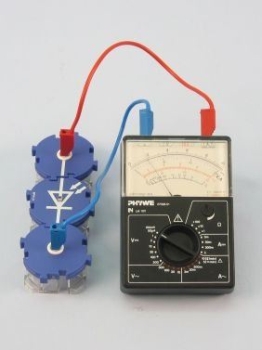Principle
The special structure of a photodiode allows light to penetrate into the border layer of the pn junction, where photon energy creates pairs of charge carriers, that allow electric current to flow. The intensity of this photo-current is proportional to the illuminating intensity, so that a photodiode is extremely suitable for optical measurement tasks. There is no linear relationship to the voltage generated by the light. Photodiodes are therefore frequently used as illumination dependent sources of current in short-circuit mode. When a voltage is applied, the photo-current is only insignificantly increased.
If the students are to recognize the linear dependence of the photo-current intensity on the illuminating intensity, then it is necessary to clarify the connection between the distance of a point light source from an irradiated surface on the one hand, and the illuminating intensity on the other hand.
The first experiment shows the proportionality between the illuminating intensity and the short-circuit current intensity of the photodiode.
Benefits
- No additional cable connections between the building blocks needed - clear arragned and quick setup
- Contact saftey due to puzzle blocks system
- Corrosion-free gold plated contacts
- Doubled earning sucess: Electric circuit diagram on top, real components can be seen unterside
Tasks
According to which principle does a photodiode work?
Examine the behaviour of a photodiode under illumination. Measure the short-circuit current intensity and the idling voltage of the photodiode at various illuminating intensities.
Recommended accessories
With these accessories you can generate real added value


